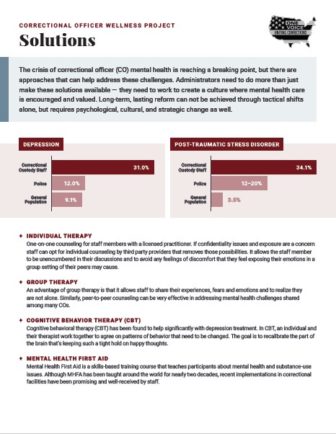The crisis of correctional officer (CO) mental health is reaching a breaking point, but there are approaches that can help address these challenges. Administrators need to do more than just make these solutions available — they need to work to create a culture where mental health care is encouraged and valued. Long-term, lasting reform can not be achieved through tactical shifts alone, but requires psychological, cultural, and strategic change as well.
Individual Therapy
One-on-one counseling for staff members with a licensed practitioner. If confidentiality issues and exposure are a concern staff can opt for individual counseling by third party providers that removes those possibilities. It allows the staff member to be unencumbered in their discussions and to avoid any feelings of discomfort that they feel exposing their emotions in a group setting of their peers may cause.
Group Therapy
An advantage of group therapy is that it allows staff to share their experiences, fears and emotions and to realize they are not alone. Similarly, peer-to-peer counseling can be very effective in addressing mental health challenges shared among many COs.
Cognitive Behavior Therapy (CBT)
Cognitive behavioral therapy (CBT) has been found to help significantly with depression treatment. In CBT, an individual and their therapist work together to agree on patterns of behavior that need to be changed. The goal is to recalibrate the part of the brain that’s keeping such a tight hold on happy thoughts.
Mental Health First Aid
Mental Health First Aid is a skills-based training course that teaches participants about mental health and substance-use issues. Although MHFA has been taught around the world for nearly two decades, recent implementations in correctional facilities have been promising and well-received by staff.
Emotional Intelligence
Emotional intelligence refers to the ability to identify and manage one’s own emotions, as well as the emotions of others. Improving EI can decrease anxiety and stress and help train staff to better handle day-to-day situations.
Cognitive Processing Therapy (CPT)
CPT teaches people to identify how traumatic experiences have affected their thinking. It also teaches them to evaluate and change their thoughts. CPT usually takes 12 sessions and can be delivered in an individual or group format. The goal is for patients to learn ways to have more healthy and balanced beliefs about themselves, others, and the world.
Exposure Therapy
This technique involves re-living the traumatic incident and is a more controversial treatment option. However, it does have its supporters and COs can work with their therapist to determine if it’s the right approach for them.
Psychodynamic Therapy
Psychodynamic therapy is a form of talk therapy. It’s designed to help patients find relief from mental or emotional stress. Proponents of psychodynamic therapy believe present-day problems are linked to unconscious conflicts arising from events in the past.
Eye Movement Desensitization and Reprocessing (EMDR)
In EMDR, patients pay attention to a back-and-forth movement or sound while calling to mind the upsetting memory until shifts occur in the way they experience that memory and more information from the past is processed. By processing these experiences, people can get relief from PTSD symptoms and change how they react to memories of their trauma.
Stellate Ganglion Block (SGB) Injections
A newer technique for treating PTSD, SGB injections – primarily used to reduce physical pain – are now being used in our veterans to deal with severe PTSD. The results have been promising from a clinical trial recently reported by JAMA Psychiatry of the American Medical Association (2016 – 2018).
Medication
Some individuals suffering from anxiety, depression, PTSD, and other mental health disorders may be prescribed medication to help manage their conditions. Side effects can be substantial and certain medications may impact awareness and function, and all COs should work with their doctors to ensure they receive the prescription that’s right for them.


No comment yet, add your voice below!